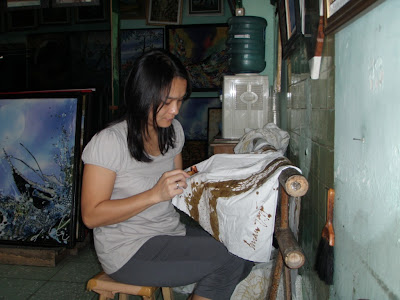

The guide of the museum then led us to a batik painting shop nearby, where our group spent a considerable amount of time choosing the paintings and haggling over the prices.


Trying my hand at batik painting

We then headed to the Kraton Complex, the palace where the Yogyakarta Sultan, Sultan Hamengku Buwono X and his family live. Many sets of gamelan (Javanese musical instruments), antiques and heirlooms are also exhibited in the many buildings within the palace comple.



Next, we went to Taman Sari, located about 2km south of Yogyakarta Palace. Also known by the Dutch name waterkasteel (water castle), it was built by a Portugese architect using European aquatic construction and adorned with Javanese ornaments. The partially ruined complex was built as a pleasure garden by the first Sultan, Sultan Hamengku Buwono I in 1765.

One of the bathing pools was dedicated to the Sultan's harem, and he had a tower overlooking the area so he could take his pick.

Outside the vicinity of Taman Sari is an underground mosque, Masjid Sokotunggal and a small village, Kampung Taman, inhabited by descendents of the Sultan’s servants.



Our next destination was the Parangtritis beach, located 27km from the city center. On the way there, we stopped by a local seafood restaurant for lunch, and that was the best lunch we had for the entire trip. The restaurant has a very nice setting with plenty of private dining huts amidst lush greenery.
We resumed our journey to Parangtritis after lunch. Reputedly the most popular beach in Yogyakarta, it has a long stretch of beach framed by steep mountainside on the east. There are plenty of horsecarts and horses to take visitors for a ride along the beach.

We left Parangtritis beach at dusk, and headed to the Manohara Hotel in Borobudur to spend the night. Dinner was at a local roadside stall selling nasi padang, mixed rice style. But the food was best forgotten.


5 comments:
very nice place, is it in indonesia?
What an interesting place to visit.
Mummy Moon - I love Borobudur and Prambanan, coming up in the next posts, not so much Yogya city itself.
Asianmommy - yes, full of interesting architecture and history.
wah taman sari vy nice eh
Jazz - nice for the olden Sultans, you mean (wink! wink!)
Post a Comment